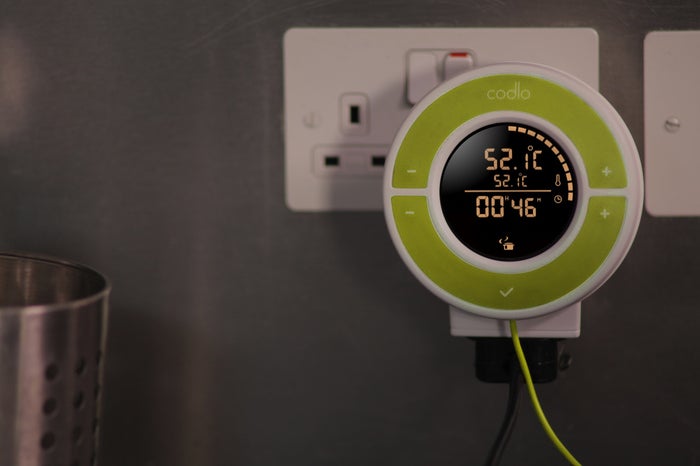We may earn revenue from the products available on this page and participate in affiliate programs. Learn more ›
We are creeping closer to the inevitable time when sous vide will be a mainstream technique in home kitchens. Sous vide, for those who need a refresher, is the increasingly popular method of cooking food enclosed in a plastic bag for a long time in a water bath at a precise temperature. Vacuum-sealing the bag is optional, but gives the technique its popular name (sous vide is French for “under vacuum”). The precise cooking produces unprecedentedly tender and flavorful meats, like a perfectly medium-rare steak or soft poached egg, with no risk of over- or undercooking.
Over the last few years, it’s spread from experimenters repurposing laboratory equipment, to innovative restaurant kitchens, to regular restaurant kitchens, to adventurous home cooks, and now seems poised to break into the conservative counter space of typical home cooks.
Accordingly, the technology has evolved to become more counter-friendly, with some very promising designs that I can’t wait to get my mitts on.
Here’s a look at how the tech is growing from the first generation of tools to a second wave that’s coming soon; and how to decide which sort of sous vide gadget you may want to invest in.
The Water Oven
When we wrote about the Sous Vide Supreme, it was the first device that went an extra distance to make controlled-temperature cooking not just possible, but appealing to the average home cook. It’s the only all-in-one device, combining the heater, container, and controller, and it has an easy-to-use interface. It comes in multiple colors and two sizes.
The Immersion Circulator: Classic
An immersion circulator, which is a little computerized pump that circulates and heats water it’s immersed in, is the industry standard. It was created for maintaining temperature-controlled baths in science laboratories. It provides the most precise and consistent temperature control, heats up quickly, and works with any container you want to use for the water bath, which makes it the most portable option — just bring the circulator over to a friend’s house; she probably has a stockpot you can use. PolyScience still has a big laboratory business, but they’ve become a big name in culinary tech as well. Until they released a $500 version of their excellent circulator last year, a circulator typically cost twice that. Christoph Milz of PolyScience explained how they lowered costs: the new machine has a fixed-speed pump, which is good enough for most people, and is manufactured overseas of a durable but less ultra-durable plastic.
The Immersion Circulator: New
The Nomiku (pictured) is a cute, friendly immersion device designed with inspiration from Ideo. It’s very hotly anticipated and due sometime this year, but its availability date keeps slipping into the future. The teeny SideKIC is a low-cost (and low-power and low-precision) immersion option, but it can be hard to find. It works only with small pots of water that you’ve already preheated, but at $170 it makes a fine entry-level option.
Plug-And-Probe: Classic
The third type of controlled-temperature cooking device is the plug-and-probe. These require you to provide your own heated water bath — most people use a rice cooker or slow cooker — which plugs into the device. A probe monitors the temperature of the bath and switches the cooker on and off to maintain it at its set point. Plug-and-probe devices have one great advantage. A circulator–because it circulates–is better at maintaining accurate temperature, even while you put things in and take things out; and it lets you use a variety of vessels. But, because it sucks the liquid from the bath up through its inner workings, you don’t want to use anything as the medium for the bath that will gum up the pump. With a plug-and-probe system, all you have to clean is the cooking vessel, so you can poach meat in stock or oil, culture yogurt, warm up chocolate, or use any other substance you can imagine. These controllers, like the ones from Auber Instruments profoundly lack the countertop-showpiece polish of a kitchen appliance. Suffice to say that my writeup of how to use the Auber was categorized as a DIY article. They also rely on convection (the natural movement of heated water) to circulate the bath (unless you add an aquarium pump or bubbler to your system) so they can be less accurate and slower to respond to changes in the bath.
Plug-And-Probe: New
At last, somebody has come up with a friendly, brightly colored plug-and-probe system. Codlo, which has achieved its £100,000 goal on Kickstarter but still has a few days left, is a plug-and-probe appliance designed with the home user in mind. Like any self-respecting counter gadget (actually it mounts directly on a wall outlet), it comes in a choice of different colors, but the attention to design includes the interface–which shows a pretty progress bar on a high-contrast LCD screen–and even the inner workings. For the Codlo, engineer Xi-Yen Tan created a new temperature-regulating algorithm called Fluid, which uses the standard PID concept but, he says, is “built to make flexible PID capabilities (which cooks need for sous-vide cooking) available for less-technically inclined cooks.”





